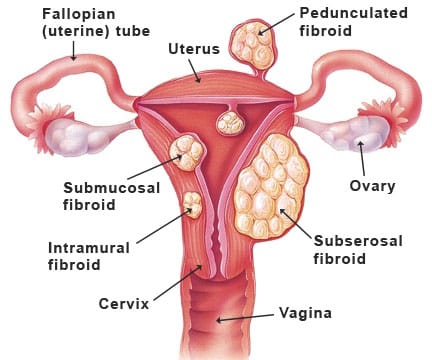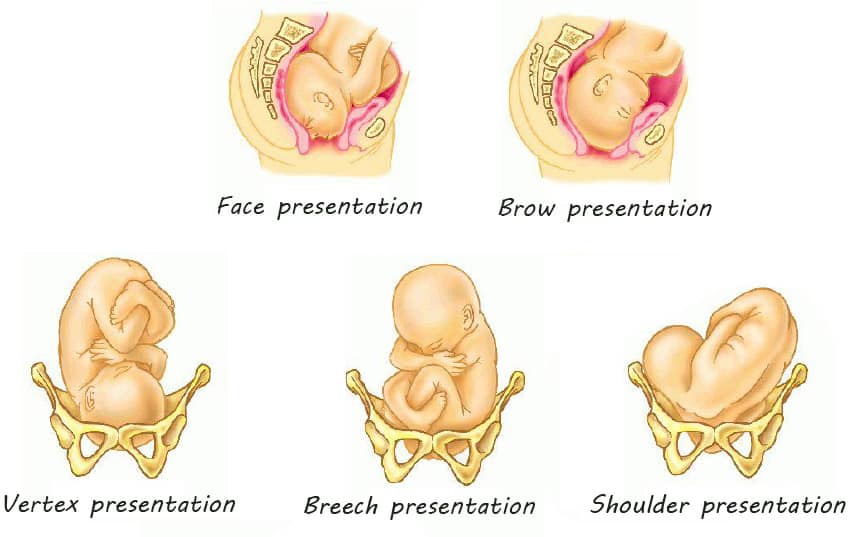What are Fibroids
Fibroids are a benign (noncarcinogenic/noncancerous) estrogen-dependent tumor of uterine smooth muscle. It can be visualized as a firm, whorled tumor to the naked eye. Approximately 20% of the women over 30 years of age are present with Fibroids.
Since these tumors present in uterine smooth muscle, it’s important to have the knowledge on layers of the uterus before we learn about fibroid.
- The female uterus consists of 3 layers. Those are,
- Endometrium (Inner layer),
- Myometrium (Middle layer), and
- Perimetrium (Outer layer).

- The endometrium is the inner epithelial layer(inner skin), with its mucous membrane.
- Myometrium is the middle layer, and it consists of smooth muscle.
- Perimetrium is the outer layer of the uterus. It consists of loose connective tissue and superficial mesothelium.
Fibroids types
Fibroids can present in different places. Based on the place, it is categorized into 6 types.
- Submucous fibroid
- Intramural fibroid
- Subserosal fibroid
- Pedunculated fibroid
- Cervical fibroid
- Fibroid in the broad ligament.

- Submucous fibroid (a)
- Those fibroids are bulging into the endometrial cavity.
- Intramural fibroid (b)
- It presents within the myometrium
- Subserosal fibroids (c)
- Those present at the outer border of the myometrium
- Pedunculated fibroids (d)
- It attached to the uterus by a narrow pedicle. that pedicle containing blood vessels which supply to the fibroid
- Cervical fibroid (e)
- Those are a presence at the cervix
- Fibroid in the broad ligament (f)
- Those are presence outside the uterus at broad ligament.

Risk factors of fibroids
- Nulliparity (women who never have completed pregnancy beyond 20 weeks.That mean women who never borne a child)
- Obesity
- Positive family history
- African racial origin (African racial are three times higher risk than others for fibroid)
Symptoms of fibroids
- Menorrhagia
- Submucosal fibroids increase the surface area of the endometrium. This can lead to menorrhagia. (heavy menstrual bleeding)
- Pressure symptoms
- The enlarged fibroid can compress the bladder and will increase pressure. This leads to an increase in the frequency of urination.
- When fibroids compress the ureter, urine cant flows normal pathways. Due to compression, obstruction causes in the pathway. It leads to the accumulation of the urine in the ureter and kidney. So it develops hydronephrosis. (Hydronephrosis is swelling of the kidney by the accumulation of the urine)
- Also, an enlarged tumor can compress abdominal veins. When this happened, it is difficult to pump blood back into the heart from the legs. This leads to the accumulation of blood in leg venous. So, both legs will get swelling(edema) and develop varicose veins.
- Pain
- When red degeneration occurs in the fibroids, pain occurs.
- Dysmenorrhea
- Usually, dysmenorrhea occurs in submucosal fibroids.
- Inter menstrual bleeding
- It happens due to necrosis and sloughing of submucosal fibroids.
- Subfertility
- Subfertility happens rarely. It happens when submucous fibroid occludes the fallopian tubes, and distortion of the endometrial cavity due to submucous fibroids. The occlusion of the fallopian tube prevents the fertilization of the ovum. Implantation of fertilized ovum prevents by large submucosal fibroid, which distorted the endometrial cavity (uterine cavity).
- Nonengaged head at term and malpresentation of the fetus
- This happens when fibroid in the cervix and in the lower uterus. It prevents rotation of the fetus, which need for labor. Usually, in labor, the fetus head engages downward, and it goes through the pelvis. To happen that process fetus has to rotate in the uterus. But due to fibroid obstructs the lower segment of the uterus, this process will not happen.



If fibroid presence in the lower part of the uterus, fetus head unable to engage in labor.
- Dysfunctional labor
- In a labor uterus contract to push the fetus to down. But the presence of fibroids leads to the difficulty to effectively contract the uterus. So labor will not happen effectively.
- Postpartum hemorrhage
- Postpartum hemorrhage is blood loss more than 500ml to 1000ml after 24 hours of childbirth. Usually, after childbirth, the uterus is undergoing a contraction. These contractions cause blood vessels in the uterus to contract and prevent bleeding from the uterus. But due to the presence of the tumor cause to decrease the contraction and it leads to increase bleeding.
Degeneration of the fibroids
Degeneration is the deteriorates of tissue function. Fibroids undergo degeneration. It happens when fibroid grows beyond its limited blood supply. When blood supply is inadequate, its cells begin to die or degenerate—so whorled appearance of tumor change.
- There are three types of degeneration that happen in the fibroids. Those are,
- Red degeneration
- Hyaline degeneration
- Cystic degeneration.
Red degeneration
Sudden active growth of the tumor leads to acute disruption of the blood supply. Usually, this happens in the 2nd trimester of the pregnancy who had a fibroid.
- In red degeneration,
- Sudden onset of pain
- Presence tenderness when palpating (touching) the uterus area
- Mild fever with high white blood cell count
These signs and symptoms resolve within a few days. So there is no need for surgical intervention. But in rare cases, it might be required.
Hyaline degeneration
In hyaline degeneration, the blood supply is not sufficient due to the gradual growth of the tumor. So the central part of the fibroid is necrosed.
Cystic degeneration
The central necrosed part of the fibroids leaves the cystic spaces at the center. Later, when the patient is not having periods (post-menopausal), this cystic part subject to calcification (deposition of calcium).
How to diagnose fibroids
- The ultrasound scan is used in the diagnostic test.
- In the abdominal examination presence of firm mass at the pelvis feels.
Treatment for fibroids
The treatments of fibroids depend on the symptoms, age, size of the fibroid, and fertility wishes.
- If the patient asymptomatic
- Usually, nothing to do if the patient is asymptomatic. But the growth rate should monitor by doing a repeat ultrasound scan (6 – 12-month interval).
- If the patient is present with menorrhagia
- Usual medical treatment for menorrhagia like Tranexamic acid, Mefenamic acid, Combined oral contraceptive pills is not effective.
- Effective treatment is gonadotrophin-releasing hormone agonist. It acts like GnRH. It increases the level of the GnRH and decreases FSH and LH production. Hence estrogen production is decreased.
- Fibroids are estrogen-dependent tumors. So lack of estrogen causes fibroids to effectively shrink, reduce the bulk, and reduce vascularity (blood supply). After shrink, it will remove by surgically.
- When GnRH agonist therapy stop, the ovarian function will return. So fibroid regrows to their previous size.
- GnRH agonist cant uses more than 6 months. Because it causes inhibition of production of the estrogen. Lack of estrogen in the body will cause severe osteoporosis.
- Surgical treatment
- Surgical treatment determined according to the presenting complaint of the patient and fertility preservation(ability to conceive).
- There are three types of surgical treatment.
- Myomectomy
- Myomectomy is done when women want to preserve their fertility. In myomectomy, only fibroids removed. The uterus is preserved.
- Hysterectomy
- Hysterectomy is removing the whole uterus. These women will be permanently sterilized.
- Uterine artery embolization
- In uterine artery embolization, the uterine artery is embolized. This resulting poor blood supply to the uterus, causing the inadequate blood supply to the fibroids.
- Hence fibroid shrink. But this leads to ovarian failure. Ultimately it will lead to infertility.
- Myomectomy
FAQ
Some fibroids are painful. When fibroids undergo different degeneration, the patient will feel a different kind of pain accordingly.
No. It is not cancerous. It is a benign tumor.
Fibroids can cause heavy menstrual bleeding. Especially in submucosal fibroids.
Usually, it will not rupture. It will undergo different phases when enlarging the size. It’s an extremely rare case to be ruptured.
